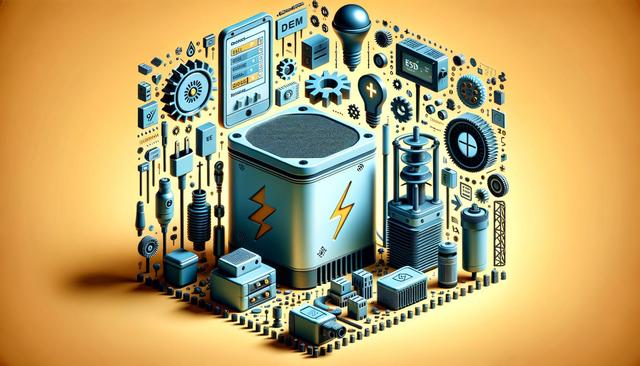
Power Supply ESD Protection Solutions: Compare Options, Prices, and Features
Understanding ESD Protection in Power Supply Systems
Electrostatic discharge (ESD) can cause significant damage to sensitive electronic components, especially in power supply systems where voltage regulation and stability are critical. ESD protection solutions are designed to mitigate these risks by channeling electrostatic energy away from vulnerable components. These solutions typically include a range of devices such as transient voltage suppression (TVS) diodes, metal oxide varistors (MOVs), and polymer-based suppressors. Each type offers distinct characteristics that influence performance, form factor, and cost.
TVS diodes are widely used due to their fast response time and low clamping voltage, which makes them suitable for protecting low-voltage interfaces. MOVs, on the other hand, offer higher energy absorption capabilities, making them more appropriate for power lines and higher voltage applications. Polymer-based suppressors are valued for their reliability and compact size, especially in portable or space-constrained systems. Understanding the specific demands of your power supply setup is essential to choosing the right ESD protection strategy.
Key Features to Evaluate in ESD Protection Devices
When comparing ESD protection options for power supplies, it’s important to consider several critical features. These features impact not only how effectively the solution protects your circuit but also how well it integrates into your existing design. Some of the most relevant specifications include:
- Clamping Voltage: The maximum voltage level the device allows before redirecting the surge.
- Response Time: How quickly the device reacts to an ESD event, ideally in nanoseconds.
- Capacitance: Lower capacitance is preferred for high-speed data lines to avoid signal distortion.
- Footprint and Mounting: Compatibility with PCB layout and manufacturing requirements.
- Operating and Storage Temperature: Suitability for the intended environmental conditions.
Manufacturers often provide detailed datasheets outlining these metrics, which can be used to compare performance across different models. It’s also worth noting that some devices come with additional certifications, like IEC 61000-4-2 compliance, indicating their ability to withstand specific ESD conditions.
Price Ranges and Cost Considerations
Pricing for ESD protection components can vary widely depending on the type, performance specifications, and purchase volume. TVS diodes are generally more affordable, with unit prices as low as a few cents when bought in bulk. MOVs are slightly more expensive due to their energy handling capabilities, while polymer-based suppressors can be on the higher end of the spectrum due to their advanced materials and compact design.
However, the cost of the component itself is only part of the equation. Additional considerations include:
- Design Integration Costs: Compatibility with existing circuit design can reduce time and engineering effort.
- Lifecycle Expenses: Longer-lasting components may reduce replacement and maintenance costs.
- Compliance and Testing: Some premium components reduce the need for external certification testing.
Ultimately, the total cost of ownership should guide your selection rather than simply the upfront component price.
Common Application Scenarios and Use Cases
Different applications call for different ESD protection approaches. For example, in industrial environments where power supplies are exposed to frequent surges and interference, MOVs are commonly used due to their robust energy-handling capabilities. In contrast, consumer electronics that require compact and lightweight components often rely on polymer suppressors or miniature TVS diodes.
Here are a few typical use cases:
- Consumer Electronics: Smartphones, tablets, and wearables favor low-capacitance TVS diodes.
- Automotive Systems: Require high-temp and vibration-tolerant solutions, often combining MOVs and TVS arrays.
- Telecommunication Equipment: Use ESD protection on power and signal lines to prevent service interruptions.
- Medical Devices: Demand high reliability and minimal signal interference, leaning toward polymer-based options.
Selecting the right ESD solution hinges on understanding the specific vulnerabilities and operational environment of your power supply system.
Tips for Selecting the Right ESD Protection Solution
Choosing the most appropriate ESD protection for a power supply involves aligning technical needs with budget and design constraints. Here are some practical guidelines to follow:
- Start with a risk assessment: Identify potential ESD sources and sensitive components.
- Match the protection level with application requirements: Over-specifying can lead to unnecessary cost and size.
- Evaluate supplier reliability: Opt for vendors with a proven track record and strong technical support.
- Prototype and test: Validate chosen components under expected ESD conditions during development.
Additionally, consider future-proofing your design by selecting components that offer scalable protection or modular implementation. This approach allows for upgrades and changes with minimal redesign, which is particularly valuable in rapidly evolving technology environments.
Conclusion: Making Informed Decisions for Long-Term Reliability
Power supply ESD protection is a critical aspect of circuit design that can significantly impact the longevity and reliability of electronic systems. With various options available—ranging from cost-effective TVS diodes to high-performance polymer suppressors—designers must weigh technical requirements against budget and integration challenges. By understanding the unique features, comparing pricing models, and aligning solutions with specific use cases, you can make informed decisions that enhance both system protection and operational efficiency. Whether you’re developing consumer electronics, industrial systems, or sensitive medical devices, thoughtful ESD protection planning will contribute to a more resilient and robust power supply design.


